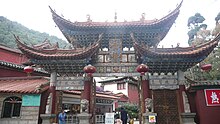Huating Temple
| Huating Temple | |
|---|---|
华亭寺 | |
 A paifang in front of Huating Temple. | |
| Religion | |
| Affiliation | Buddhism |
| Sect | Weiyang school[1] |
| Leadership | Shi Xinming (释心明)[1] |
| Location | |
| Location | Xishan District, Kunming, Yunnan |
| Country | China |
| Geographic coordinates | 24°58′39″N 102°38′03″E / 24.977383°N 102.634243°E |
| Architecture | |
| Style | Chinese architecture |
| Founder | Xuantong Yuanfeng |
| Date established | 1320 |
| Completed | 1334 |
Huating Temple (simplified Chinese: 华亭寺; traditional Chinese: 華亭寺; pinyin: Huátíng Sì) is a Buddhist temple located in Xishan District of Kunming, Yunnan, China.[2][3][4]
History
[edit]
Yuan dynasty
[edit]The temple was first established by Xuantong Yuanfeng (玄通元峰) in 1320, during the mid-Yuan dynasty (1271–1368).[1] The construction was completed in 1334. In 1339, Xuantong Yuanfeng brought a set of Chinese Buddhist canon to the temple after he visited Jiangnan. At that time it initially called "Yuanjue Temple" (圆觉寺).[5]
Ming dynasty
[edit]In 1441, Emperor Yingzong of the Ming dynasty (1368–1644) renamed it "Huating Temple" (华亭寺). This name has been used to date. In 1453, Emperor Yingzong sent a eunuch named Li Yi (黎义) to renovate and redecorate the temple.[5]
After the fall of the Ming dynasty, Huating Temple was devastated by wars.
Qing dynasty
[edit]In 1687, during the reign of Kangxi Emperor (1662–1722) of the Qing dynasty (1644–1911), the provincial governor of Yunnan Wang Jiwen (王继文) rebuilt the temple.[5]
In 1857, in the Xianfeng era (1851–1861), Part of the temple was badly damaged in the Hui Uprising.
Huating Temple was restored in 1883 with a small-scale.
Republic of China
[edit]In 1920, Military Governor of Yunnan Tang Jiyao invited Hsu Yun to disseminate Buddhism. Hsu Yun supervised the reconstruction of Huating Temple.[5]
People's Republic of China
[edit]In 1969, the Buddhist Texts Library became dilapidated for neglect. It was demolished in the following year.
Huating Temple has been designated as a National Key Buddhist Temple in Han Chinese Area by the State Council of China in 1983.
Architecture
[edit]

Along the central axis are the Four Heavenly Kings Hall, Mahavira Hall, Guanyin Hall and Buddhist Texts Library. There are over 10 halls and rooms on both sides, including Guru Hall, Abbot Hall, Monastic Dining Hall, Monastic Reception Hall and Meditation Hall.
Four Heavenly Kings Hall
[edit]Statues of lion and elephant stands in front of the Four Heavenly Kings Hall. On both sides of the hall there are the statues of Heng and Ha. In the center of the hall enshrines the statues of Maitreya Buddha and Skanda. Statues of Four Heavenly Kings are enshrined in the left and right side of the hall.[5]
Mahavira Hall
[edit]The Mahavira Hall enshrining the statues of Sakyamuni, Amitabha and Bhaisajyaguru. In front of Sakyamuni stand Ananda and Kassapa Buddha on the left and right. At the back of Sakyamuni's statue are statues of Guanyin and Twenty-four Gods of Heaven. Totally 500 niches with small statues of Arhats are carved on both sides of the bounding walls.[5]
References
[edit]- ^ a b c Shi Yuanzong (2017-09-28). 喜讯!千年古刹昆明华亭寺今日起免票进寺. Tencent (in Chinese). Archived from the original on 2018-05-09. Retrieved 2018-05-09.
- ^ "Huating Buddhist Temple". Kunming Municipal Tourism Development Commission. 7 April 2015. Retrieved 9 May 2018.
- ^ 昆明华亭寺28日起免票. Xinhua News Agency (in Chinese). 2017-09-29. Archived from the original on September 29, 2017.
- ^ 昆明华亭寺举行浴佛仪式 庆祝释迦牟尼佛诞辰. Chinanews (in Chinese). 2017-05-03.
- ^ a b c d e f Yan Nian (2011-02-21). 华亭寺:云南禅宗第一祖师玄峰结茅修行地. iFeng (in Chinese).


